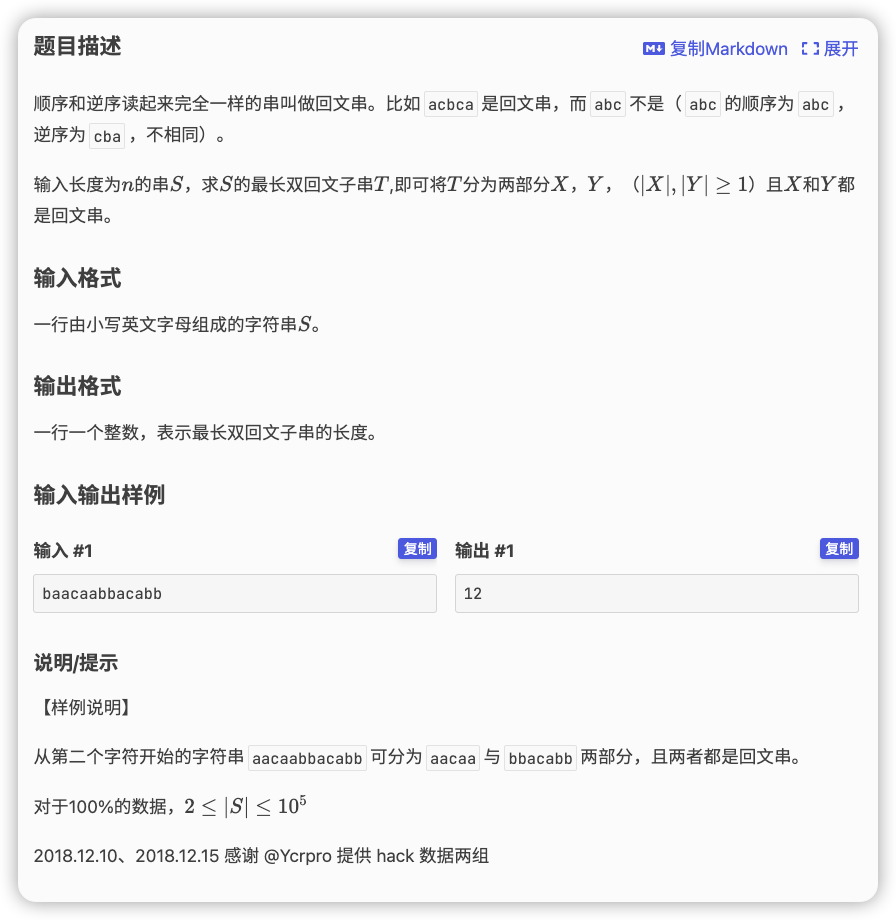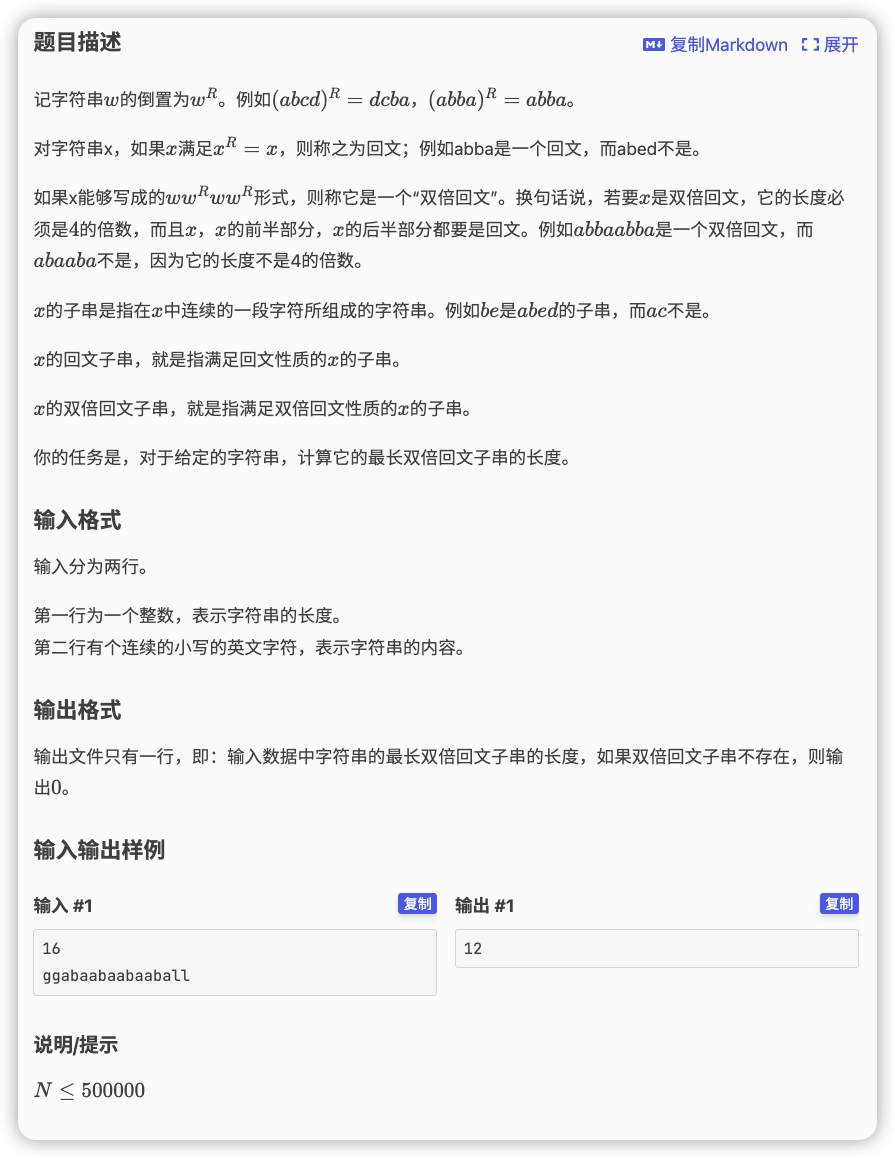回文自动机
Chivas-Regal
#
# 洛谷P4555_最长双回文串
# 🔗
# 💡
要求连续两段子区间满足某种性质,求最长的两段子区间的和,这种问题如果一个子区间很好求的话,可以通过枚举断点实现正反效果
即类似于 CodeForces1409E_TwoPlatforms 的操作,在断点为 时,加上正的 和反的 来使得两个最长的单子区间拼成的双子区间最长
这里求一个最长回文子串很好求,求一个以 结束的最长回文子串也很好求,当然这都是建立在 上是前缀的后缀来定的,对于反向的最长单子区间,只需要将字符串反过来再跑一遍 同时维护数值即可
# ✅
const int N = 1e6 + 10;
char s[N];
struct PalindromeAutoMaton {
int ed, ct;
int fa[N], len[N], to[N][26];
inline PalindromeAutoMaton () {
ed = 0; ct = 1;
fa[0] = 1; len[1] = -1;
}
inline int get_fa (int u, int id) {
while (id - len[u] - 1 < 1 || s[id - len[u] - 1] != s[id]) u = fa[u];
return u;
}
inline void insert (int c, int id) {
int father = get_fa(ed, id);
if (!to[father][c]) {
fa[++ct] = to[get_fa(fa[father], id)][c];
to[father][c] = ct;
len[ct] = len[father] + 2;
}
ed = to[father][c];
}
inline void clear () {
for (int i = 0; i <= ct; i ++) {
fa[i] = len[i] = 0;
for (int j = 0; j < 26; j ++) to[i][j] = 0;
}
ed = 0; ct = 1;
fa[0] = 1, len[1] = -1;
}
} pam;
int a[N], b[N];
int main () {
scanf("%s", s + 1); int n = strlen(s + 1);
for (int i = 1; i <= n; i ++) {
pam.insert(s[i] - 'a', i);
a[i] = pam.len[pam.ed];
}
pam.clear();
reverse(s + 1, s + 1 + n);
for (int i = 1; i <= n; i ++) {
pam.insert(s[i] - 'a', i);
b[n - i + 1] = pam.len[pam.ed];
}
int res = 0;
for (int i = 1; i < n; i ++) {
res = max(res, a[i] + b[i + 1]);
}
printf("%d\n", res);
}
1
2
3
4
5
6
7
8
9
10
11
12
13
14
15
16
17
18
19
20
21
22
23
24
25
26
27
28
29
30
31
32
33
34
35
36
37
38
39
40
41
42
43
44
45
46
47
48
49
50
51
52
2
3
4
5
6
7
8
9
10
11
12
13
14
15
16
17
18
19
20
21
22
23
24
25
26
27
28
29
30
31
32
33
34
35
36
37
38
39
40
41
42
43
44
45
46
47
48
49
50
51
52
# 洛谷P4287_双倍回文
# 🔗
# 💡
分析一下这样的双倍回文串的性质:
长度是 的倍数
自己是回文串
长度是自己一半的后缀/前缀串依然是回文串
由于 的 树上一个点的祖先是按长度从大到小的它的回文后缀,因此如果一个节点是双倍回文串,那么它的祖先中一定会存在长度是它一半的回文串,故先按 树建一个树图
一个检查树上祖先中是否和它有一定关系限制的点的问题,可以直接使用 ,一个 数组记录祖先中存在什么,在进入 时加上,退出时减去,每一个点判断一下是不是四的倍数以及 是否存在
# ✅
const int N = 1e6 + 10;
int n;
char s[N];
struct PalindromAutoMaton {
int ed, ct;
int len[N], fa[N], to[N][26];
inline PalindromAutoMaton () {
ed = 0; ct = 1;
fa[0] = fa[1] = 1; len[1] = -1;
}
inline int get_fa (int u, int id) {
while (id - len[u] - 1 <= 0 || s[id - len[u] - 1] != s[id]) u = fa[u];
return u;
}
inline void insert (int c, int id) {
int father = get_fa(ed, id);
if (!to[father][c]) {
fa[++ct] = to[get_fa(fa[father], id)][c];
to[father][c] = ct;
len[ct] = len[father] + 2;
}
ed = to[father][c];
}
} pam;
struct Edge {
int nxt, to;
} edge[N]; int head[N], cnt;
inline void add_Edge (int from, int to) {
edge[++cnt] = {head[from], to};
head[from] = cnt;
}
int num[N], res;
inline void dfs (int u) {
if (pam.len[u] % 4 == 0 && num[pam.len[u] / 2]) res = max(res, pam.len[u]);
num[pam.len[u]] ++;
for (int i = head[u]; i; i = edge[i].nxt) {
int v = edge[i].to;
dfs(v);
}
num[pam.len[u]] --;
}
int main () {
scanf("%d%s", &n, s + 1);
for (int i = 1; i <= n; i ++) pam.insert(s[i] - 'a', i);
for (int i = 0; i <= pam.ct; i ++) {
if (i != 1) add_Edge(pam.fa[i], i);
}
dfs(1);
printf("%d", res);
}
1
2
3
4
5
6
7
8
9
10
11
12
13
14
15
16
17
18
19
20
21
22
23
24
25
26
27
28
29
30
31
32
33
34
35
36
37
38
39
40
41
42
43
44
45
46
47
48
49
50
51
52
53
2
3
4
5
6
7
8
9
10
11
12
13
14
15
16
17
18
19
20
21
22
23
24
25
26
27
28
29
30
31
32
33
34
35
36
37
38
39
40
41
42
43
44
45
46
47
48
49
50
51
52
53


